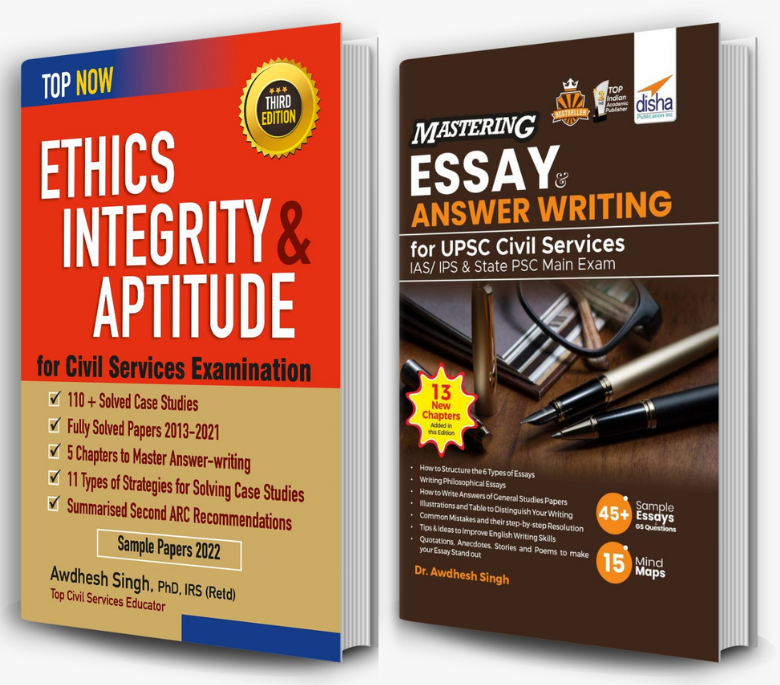Essay and Answer Writing → Model Essays
Topics
All
Civil Services in India (26)
Ethics, Integrity and Aptitude
» Chapters from Book (11)
» Case Studies (8)
Solved Ethics Papers
» CSE - 2013 (18)
» CSE - 2014 (19)
» CSE - 2015 (17)
» CSE - 2016 (18)
» CSE - 2017 (19)
» CSE - 2018 (19)
» CSE - 2019 (19)
» CSE - 2020 (19)
» CSE - 2021 (19)
» CSE -2022 (17)
» CSE-2023 (17)
Essay and Answer Writing
» Quotes (34)
» Moral Stories (18)
» Anecdotes (11)
» Beautiful Poems (10)
» Chapters from Book (5)
» UPSC Essays (40)
» Model Essays (38)
» Research and Studies (4)
Economics (NCERT) Notes
» Class IX (14)
» Class X (16)
» Class XI (55)
» Class XII (53)
Economics Current (51)
International Affairs (20)
Polity and Governance (61)
Misc (77)
Select Topic »

Civil Services in India (26)
Ethics, Integrity and Aptitude (-)
» Chapters from Book (11)
» Case Studies (8)
Solved Ethics Papers (-)
» CSE - 2013 (18)
» CSE - 2014 (19)
» CSE - 2015 (17)
» CSE - 2016 (18)
» CSE - 2017 (19)
» CSE - 2018 (19)
» CSE - 2019 (19)
» CSE - 2020 (19)
» CSE - 2021 (19)
» CSE -2022 (17)
» CSE-2023 (17)
Essay and Answer Writing (-)
» Quotes (34)
» Moral Stories (18)
» Anecdotes (11)
» Beautiful Poems (10)
» Chapters from Book (5)
» UPSC Essays (40)
» Model Essays (38)
» Research and Studies (4)
Economics (NCERT) Notes (-)
» Class IX (14)
» Class X (16)
» Class XI (55)
» Class XII (53)
Economics Current (51)
International Affairs (20)
Polity and Governance (61)
Misc (77)

IT Revolution and e-Waste
“E-recycling gives health to all!” – When we throw something away, it has to go somewhere. However, we almost always forget about this while discarding items we deem ‘waste’. Electronic waste or e-waste is one of the most popularly growing issues of the world, gradually becoming a growing concern for the environment. While e-waste contains both valuable materials such as gold, palladium, silver and copper, it also contains harmful metals like lead, cadmium and mercury. In the absence of suitable techniques and protective measures, recycling e-waste can result in toxic emissions to the air, water and soil and pose a serious health and environmental hazard. In India, e-waste is mostly generated in large cities like Delhi, Mumbai and Bangalore. In these cities a complex e-waste handling infrastructure has developed mainly based of a long tradition of waste recycling. But the problem is that these recycling processes are extremely harmful and have negative impacts on the worker’s health and the environment. In this essay, we trace the meaning of e-waste, its ways of disposal, the hazards of disposal and possible solution.
What is IT Revolution and e-waste?
The expression ‘Information Technology Revolution’ refers to a far-reaching phenomenon related to innovations that are occurring at a phenomenal rate in the information and communication technologies (ICTs). A convergence is happening in technical aspects between computing and telecommunication, in contents between text, images, voice and sound, and in the ways in which information is delivered. Technical innovations associated with the ongoing process of liberalisation and deregulation of markets and world backbone networks are resulting in cheaper, faster and easier internet access. These innovations are substantially transforming the ways in which goods and services are produced, distributed and consumed, and are improving our mobility and increasing the diffusion of ideas and innovations.
E-waste or electronic waste can be understood as a part and consequence of the IT revolution. It refers to when an electronic product is discarded after the end of its useful life. The rapid expansion of technology and the consumption driven society results in the creation of a very large amount of e-waste in every minute. Used electronics which are destined for refurbishment, reuse, resale, salvage recycling through material recovery, or disposal are also considered e-waste.
Though there is no generally accepted definition of e-waste, in most cases, e-waste comprises of relatively expensive and essentially durable products used for data processing, telecommunication or entertainment in private households and businesses. Public perception of e-waste is often restricted to comprising mainly of end-of-life information and telecommunication equipment and consumer electronics.
Problems of e-waste generation
(Sources: guardian.com / researchgate.net / Wikipedia.com)
The world is consuming more and more electronic products every year. This has caused a dangerous explosion in electronic scrap containing toxic chemical and heavy metals that cannot be disposed of or recycled safely. E-waste is assuming serious proportions in India and urgent steps need to be taken to mitigate this problem. During the last century scientist, diplomats and entrepreneurs were concerned about pollution. In the mid of 20th century, they were worried about air, water, soil and municipal solid waste pollution. And during the starting of 21st century an increased the demand of electronic and electrical equipments like desktop, laptop, mobile phones, refrigerators, televisions, etc. as well as rapid changes in information and communication technologies, have led to a drastically reduced lifespan for most electronic equipment. This reduced lifespan of the device cause electronic waste and it is the fastest-growing pollution and it is becoming complicated day by day globally. Some major causes of e-waste generation include:
·Upgrade and innovation in technology
·Lifestyle changes
·End of the intended usage
Major issues that are caused by e-waste are:
·Improper handling of e-waste is detrimental to the environment and mankind. Since this waste is nothing but a combination of plastics and toxic chemicals, these get released into the environment.
·Pollutants such as dioxins and furans from polyvinyl chloride, lead, beryllium, cadmium, mercury, etc. get into our environment.
·Depending on the age and type of the discarded item, the chemical composition of e-waste may vary. Most e-waste are composed of a mixture of metals like Cu, types of plastics and ceramics. E-waste has a horrible effect on the environment and it is important to dispose it with an ‘R2 certified’ recycling facility.
·Exposure to harmful chemicals present in e-waste can lead to severe health hazards that are at times fatal. These toxins enter our body through inhalation, skin absorption, or ingestion. After that, humans run the risk of developing any of the above-mentioned conditions. Some health problems caused due to it are:
a. Reproductive issues
b. Damaged immune system
c. Damaged nervous system
d. Kidney damage
e. Breathing/respiratory issues
f. DNA damage
g. Muscle weakness
h. Lung cancer
·Of the total e-waste generated in the country, western India accounts for the largest population at 35%, while the southern, northern and eastern regions account for 30, 21 and 14%, respectively. The top states in order of highest contribution to waste electrical and electronic equipment (WEEE) include Maharashtra, Andhra Pradesh, Tamil Nadu, Uttar Pradesh, West Bengal, Delhi, Karnataka, Gujarat, Madhya Pradesh and Punjab.
·The following 3 account for almost 90% of the generation: Large household appliances: 42%; Information and communications technology equipment: 33.9%; and Consumer electronics: 13.7%.
Solutions and Policies
Given the large-scale harmful effects of e-waste, it is important that we find sustainable ways to dispose e-waste, create awareness amongst citizens, clubs and schools for safe disposal of electronic items. Tossing around the responsibility for management of e-waste is something we are used to as a society. The government is often brought under the radar for not taking adequate measures to turn it into a well-managed system. Also, we see it as a responsibility of the government to carry out awareness programs to make the masses aware of what they are expected to do with their appliances. However, according to the E-Waste Management Rules 2016, it is the responsibility of equipment manufacturers to take up the task of recycling the products they produce.
Some progress that has been made it terms of solutions and policies include:
(Source: https://www.ncbi.nlm.nih.gov/pmc/articles)
·Draft Hazardous Materials (Management, Handling and Transboundary movement) Rules, 2007 part of the Environment Protection Act, 1986.
·India is a signatory to the Basal Convention on the control of Transboundary Movement of Hazardous wastes and their disposal.
·There is no policy on e-waste, although some parts of computers could be considered as hazardous waste.
·Knowledge bank for e-waste management in India - The Asia Pro Eco-programme supported by the European Commission is dedicated to the environmental performance in Asian Economic sectors through the exchange of environmental policies, technologies and practices and to promote sustainable investment and trade between the European Union Member States and South Asia, South-East Asia and China.
·The E-waste Guide, India (www.ewaste.in) - An Initiative of the Indo–German–Swiss Partnership, designed to serve as an information resource on e-waste as well as a common collaborative work platform for stakeholders.
·National Solid Waste Association of India (NSWAI) (www.nswai.com) – formed in 1996, it is a professional non-profit organization in the field of solid-waste management, including toxic and hazardous waste and also biomedical waste in India. Its objectives include development of solid-waste management as a profession, research and development, development of expertise, standards and goods practices with regards to solid-waste management.
·Waste minimisation in industries involves adopting:
a. Inventory management
b. Production process modification
c. Volume reduction
d. Recovery and reuse
·Sustainable product design involves:
a. Rethinking on procedures of designing the product (flat computers)
b. Use of renewable material and energy
c. Creating electronic components and peripherals of biodegradable material
d. Looking at a green packaging option
·Restructuring recycling - Some recycling procedures require improvements, up-gradation (both in skills and technologies) and some have to be abandoned altogether due to severe risks for health and the environment.
·Awareness building - The current awareness regarding the existence and dangers of e-waste are extremely low, partly because the e-waste being generated is not as large as in developed countries. Urgent measures are required to address this issue.
Conclusion
We must ponder over the idea that if responsibility ever comes to as a society, we are responsible for discarding our e-waste. A balance between 3 institutions – government, manufacturers and society – is what India needs to manage its e-waste better. The need of the hour is an urgent approach to the e-waste hazard by technical and policy-level interventions, implementation and capacity building and increase in public awareness such that it can convert this challenge into an opportunity to show the world that India is ready to deal with future problems and can set global credible standards concerning environmental and occupational health.

Looking for a One-stop Solution to prepare for ‘Ethics, Integrity, and Aptitude’ and ‘Essay and Answer Writing’ for UPSC?
Buy Dr. Awdhesh Singh’s books from the links below-
Ethics, Integrity & Aptitude for Civil Services Examination
Amazon - https://amzn.to/3s1Qz7v
Flipkart - https://bit.ly/358N2uY
Mastering Essay & Answer Writing for UPSC Civil Services
Amazon - https://amzn.to/3JELE2h
Flipkart - https://bit.ly/3gVIwmv
| Related Articles |
| Recent Articles |
